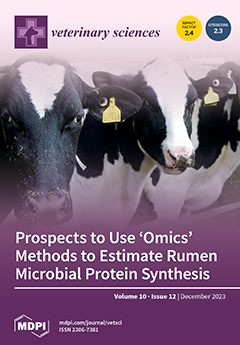This study assessed the impact of a mixture of garlic (
Allium sativum) and oregano (
Origanum vulgare) essential oils (EOGOs) on in vitro dry matter digestibility (IVDMD) and in vivo apparent nutrient digestibility. Different EOGO inclusion levels were evaluated to assess the dose response and potential effects of the mixture. Three EOGO inclusion levels (0.5, 0.75, and 1 mL/kg of incubated dry matter) were evaluated in vitro, while four treatments (0.5, 0.75, and 1 mL/day of EOGO and a control group) were tested in vivo on 12 West African sheep. A randomized controlled trial was conducted using a 4 × 4 design. Blood parameters (glucose, blood urea nitrogen, and β-hydroxybutyrate) were measured to observe the effect of EOGO on the metabolism. The results showed that the inclusion of EOGO significantly enhanced IVDMD at low levels (
p < 0.052) compared with the highest levels in treatments containing 0.5 and 0.75 mL/kg of EOGO dry matter. A higher intake of dry matter (DM), crude protein (CP), and neutral detergent fiber (NDF) (
p < 0.05) was observed in the in vivo diets with the inclusion of EOGO. In terms of in vivo apparent digestibility, significant differences were found among treatments in the digestibility coefficients of DM, CP, and NDF. EOGO inclusion increased the digestibility of DM. CP digestibility displayed a cubic effect (
p < 0.038), with the lowest values of digestibility observed at 1 mL EOGO inclusion. Additionally, NDF digestibility showed a cubic effect (
p < 0.012), with the highest value obtained at 0.75 mL of EOGO inclusion. The inclusion levels above 0.75 mL EOGO showed a cubic effect, which indicates that higher concentrations of EOGO may not be beneficial for the digestibility of CP and NDF. Although no significant difference was observed in total digestible nutrients, a linear trend was observed (
p < 0.059). EOGO improved the intake of DM, CP, and NDF. EOGO supplementation improved the digestibility of DM and NDF, with optimal levels observed at 0.5 mL/day. No significant effects were observed in the blood parameters. These results suggest that EOGO has the potential as an additive in ruminal nutrition to improve food digestibility and serve as an alternative to antibiotic additives. The use of EOGO potentially improves fiber digestion and may reduce the use of antibiotics in livestock production. Garlic (
A. sativum) and oregano (
O. vulgare) essential oils effectively modulated fiber digestibility at 0.75 mL/day. Garlic (
A. sativum) and oregano (
O. vulgare) essential oils have the potential to improve digestibility at low inclusion levels and serve as an alternative to antibiotic additives. The effectiveness of essential oils is greater in a mixture and at lower doses.
Full article






